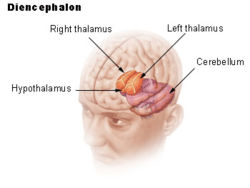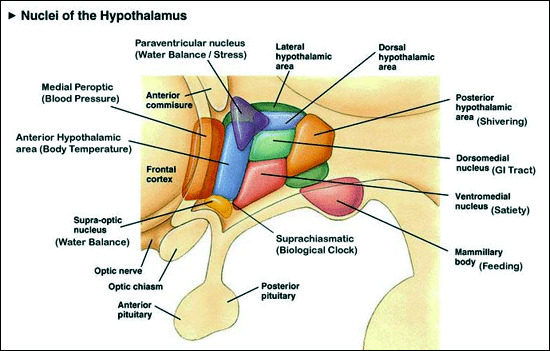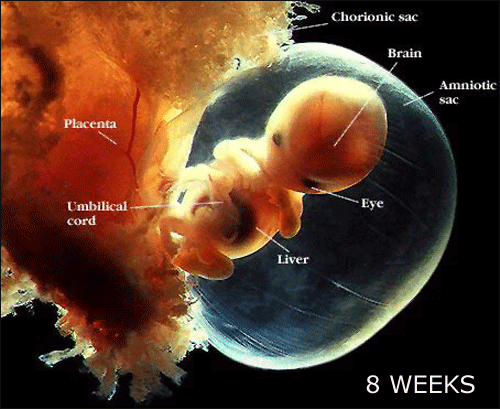A Review of Scientific Research on Homosexuality
In 1959 a report was published with the title, "Organizing action of prenatally administered testosterone propionate on the tissues mediating mating behavior in the female guinea pig" by Charles H. Phoenix, Robert W. Goy, Arnold A. Gerall, and William C. Young [6]. This was one of those "animal studies" -- of interest only to psychologists and neurologists. In 1991, the popular journal, Science, published a paper that revisited the 1959 report and included many more recent studies. Their paper came to the conclusion:
"This finding indicates that INAH [part of the hypothalamus] is dimorphic with sexual orientation, at least in men, and suggests that sexual orientation has a biological substrate." [4]
Ever since Science published the article, I've been waiting for the big changes. But they have been slow. Public opinion still maintains that homosexuals have chosen to live a deviant lifestyle. Some of the worst hate towards homosexuals -- from an anti-homosexual religious group that targets veteran's funerals [below] -- comes from the belief that it is a chosen lifestyle.
Ignorance about the cause of homosexuality has been responsible for many teen suicides as well as violence against teens who are perceived as different by their classmates. School officials, even parents of homosexual children, do little to clarify this condition and seem often to turn away from the issue all together.

Many church leaders continue to equate homosexuality as a sin, suggesting that through prayer they could be "made whole." The husband of one of the top Republican presidential candidates runs a clinic, claiming to be able to "cure" homosexuality as if it were merely a bad decision. This view is echoed in many religious churches, based on the writings of Apostle Paul:
"Do not be deceived: Neither the sexually immoral nor idolaters nor adulterers nor male prostitutes nor homosexual offenders nor thieves nor the greedy nor drunkards nor slanderers nor swindlers will inherit the kingdom of God. And that is what some of you were. But you were washed, you were sanctified, you were justified in the name of the Lord Jesus Christ and by the Spirit of our God." -- I Corinthians 6:9-11 (NIV)
What's going on here? Can homosexuality be "washed away" with Conservative beliefs?
Homosexuality: Born That Way
The Conservapedia states that:
"The causes of homosexuality are attributable to man's sinful nature, nurture and environment, and personal choice." [5]
But scientific research directly contradicts this.
Homosexuality is a congenital condition much like being "left handed". Before you dismiss the analogy remember there were times in history when being left-handed (the archaic meaning of "sinister") meant you were possessed by evil. You could have been hanged, burned, stoned to death or buried alive. Having personally lived in an Arab country, I can assure you that being left-handed was something that I did my best to hide. Today we know that left handedness is the result of excess testosterone slowing the growth of the left-hemisphere in the developing fetal brain.[2] It's not a choice. It's a condition.
Ironically, homosexuality is caused much the same way as being left-handed. Instead of excess testosterone, the developing male fetus receives too little, often too late.
 Researchers naturally focus on an organ in the brain called thehypothalamus because it is known to be responsible for gender preference. It is also what is called dimorphic, meaning its structure is different in males and females. There's also differences in the hypothalamus between homosexuals and heterosexuals. Recent studies of the different sections or nuclei have revealed much that was not known before. And there have also been some surprises.
Researchers naturally focus on an organ in the brain called thehypothalamus because it is known to be responsible for gender preference. It is also what is called dimorphic, meaning its structure is different in males and females. There's also differences in the hypothalamus between homosexuals and heterosexuals. Recent studies of the different sections or nuclei have revealed much that was not known before. And there have also been some surprises.
With advances in laboratory technology, a specific region of the hypothalamus, called the sexually dimorphic nucleus (SDN), has been the focus of some interesting research. The SDN is the most conspicuous anatomical male/female difference in the mammalian brain. The nuclei is 3 to 8 times larger in males than in females. Another nuclei of the hypothalamus, INAH-3, reveals that heterosexual males have double the volume of both homosexual and female subjects.

"As has been reported previously, INAH 3 was more than twice as large in the heterosexual men as in the women. It was also, however, more than twice as large as in the homosexual men." [4]
A review of current research shows that there is no evidence supporting a social cause for homosexuality [8, 9]. On the contrary, there are multiple studies, both with animals and humans, demonstrating the causative relationship with the pre-natal testosterone during a critical stage in "defeminization".
Dr. Harry Harlow's famous studies with Rhesus monkeys [5] demonstrated that such things as love and the ability to nurture healthy children was a learned skill that could be altered by after birth experiences. This non-biologic effect may play a role in female homosexuality and may also be a contributing factor in the degree to which congenital homosexuality is either expressed or repressed. But they do not cause homosexuality.
How Do Brains Get Gender?
Embryology teaches that early embryos all start out as female. At some point in early gestation, if the chromosomes destine the fetus to be male, the embryo is altered by the genetically programmed addition of certain hormones, called androgens. These androgens, especially testosterone, instruct the embryo to develop male characteristics. In their absence, the embryo continues to develop into a female.
An "XX" pair of chromosomes will yield a female; an "XY" pair will result in a male. The "X" is always contributed from the mother (since she has only "X's"), but the father can contribute either an "X" or a "Y"-- so it is the father's genetic contribution that determines the gender of the child. If homosexual men have "XY" pairs which are typically male in all respects, what makes their hypothalamus different?

In a paper published almost a quarter of a century ago, a research psychologist at Villanova University was also puzzled about gender. Dr. Ingebog Ward was studying the sexual behavior of rats, years before the role of the hypothalamus was even suspected of gendering human brains. [6]
Dr. Ward divided some pregnant rats into three groups. Suspecting that something special might be happening in the early stages of pregnancy, she subjected the first group to stress during the first ten days of gestation by irritating the mother rats to bright lights, noise and annoying vibrations. Ten days in a rat's pregnancy corresponds to the first trimester (3 months) of a human pregnancy. The second group was subjected to stress towards the end of their pregnancy, just before birth. The third group was comprised of male offspring from both prenatal stressed mothers and unstressed mothers. These babies were subjected to the same stress producing stimuli.
Dr. Ward then allowed all the males to grow to adulthood without further interference. She then placed each group of males in cages with healthy females to observe their ability and desire to mate with normal adult females. Here is what happened:
"Abstract: Male rats were exposed to prenatal (i.e. before they were born) or postnatal (after they were born) stress, or both. The prenatally stressed males showed low levels of male copulatory behavior and high rates of female lordotic responding (i.e. "lordotic" refers to mounting behavior which usually occurs during mating). Postnatal stress had no effect. The modifications are attributed to stress-mediated alterations in the ratio of adrenal to gonadal androgens during critical stages of sexual differentiation. Specifically, it appears that stress causes an increase in the weak adrenal androgen, androstendione, from the maternal fetal adrenal cortices, or both, and a concurrent decrease in the potent gonadal androgen, testosterone." [6]
If the baby carries "XY" chromosomes and is destined to become a male, testosterone needs to activate the newly forming hypothalamus. This is the first known critical phase of "defeminization" when something can go awry, upsetting the master plan.[10]
If a mother is stressed during the early stages of pregnancy, she will release an adrenaline related hormone into her shared bloodstream with her unborn baby. This hormone, called androstendione, is structurally similar to testosterone, the male hormone. Both are androgens, but testosterone is more than twenty times as potent as androstendione.
It has also recently been suggested that testosterone actually breaks down to estradiol in some way that androstendione may not [12, 15], further implicating this androgen in disrupting the process of early brain development.
Because the stress hormone seems to mimic testosterone, there is the delay or blockage of the effectiveness of testosterone, even if it is plentiful. This causes a disturbance in the "defeminization" of the hypothalamus [7].

In 1972, Dr. Ward had no idea that androstendione in male pregnancies would prevent or inhibit the hypothalamus to develop into a healthy male brain, but this stress-related hormone now appears to do just that. The brain makes its gender commitment very early in development and, once committed to either male or female, it can not change.
The interference with environmental testosterone in the later stages of pregnancy does little or nothing to inhibit gender development of the body. By mid-pregnancy, the gonads can produce enough systemic testosterone to develop the body along male plans; however, problems do happen in these later stages [11]. Sometimes the receptors which receive testosterone are defective or greatly reduced in number. This is generally seen as a defect resulting from the initial blocking of testosterone by the presence of other androgens [7]. This can inhibit the effectiveness of testosterone and cause a less effective defeminization.
In Doctor Ward's own words:
"...The present data support the hypothesis that exposure of pregnant rats to environmental stressors modifies the normal process of sexual behavior differentiation in male fetuses by decreasing functional testosterone and elevating androstenedione levels during prenatal development. During stress conditions plasma testosterone emanating from the gonads decreases while adrenal androstenedione rises. The molecular structure of the two androgens, being very similar, it is postulated that the two hormones compete for the same receptor sites. Since androstenedione is a less potent androgen than testosterone, the decrease in male copulatory ability and increased lordotic potential seen in the prenatally stressed animals of the present study would be expected. The relative difference in potency between testosterone and androstendione has been repeatedly demonstrated. [Ibid.]
But Why?
 As we begin to understand that homosexuality is not inherited, we note that it occurs in more or less the same frequency of the population. This could suggest that a preference for one's own gender served some evolutionary benefit. If not, we should expect the perceived vulnerability of the developing fetal brain to have been corrected. But what could the benefit be?
As we begin to understand that homosexuality is not inherited, we note that it occurs in more or less the same frequency of the population. This could suggest that a preference for one's own gender served some evolutionary benefit. If not, we should expect the perceived vulnerability of the developing fetal brain to have been corrected. But what could the benefit be?
Again, in Doctor Ward's own words:
"The resulting alterations in sexual behavior provide the basis for an effective population control mechanism, since offspring so affected would not possess the behavioral repertoire necessary to contribute to population growth. Thus, the environment, by triggering an adrenal stress response, may control the reproductive capacity of successive generations of differentiating fetuses and, thereby, population size. "
[Some more recent explanations from a 2010 ScienceDaily article can be found at the bottom of this page.]
What about Lesbians?
The developing female fetus is expecting no pre-natal testosterone. This molecule is significant only if the fetus is destined to be male. Androstenedione, produced by maternal stress, closely resembles testosterone. Even a small amount of this molecule during the critical first trimester of pregnancy could be enough to make the developing hypothalamus defeminized or masculine. So the same mechanism can possibly explain both male and female homosexuality.
Now what?
I approached some homosexual blogs before posting this article on viewzone. I summarized the facts and asked for their replies. Some were critical of calling their gender preference a "condition" and thought that implied a defect. Others reminded me that even the anti-discrimination laws often only include protection against discrimination based on sex (meaning male of female) and that being recognized as a congenital phenomenon would only be protected if (a) it was considered a "disability" or (b) homosexuality would be covered under sex discrimination (meaning that a third gender would have to be added). In short, there was a kind of apathy.
What do you think about this?
Notes:
[1] Swaab, DF, Hofman, MA, "Sexual differentiation of the human hypothalamus in relation to gender and sexual orientation", Trends Neuroscience 1995 June, 18(6): 264-70.
[2] NORMAN GESCHWIND, PETER BEHANI!,Left-handedness: Association with immune disease, migraine, and developmental learning disorder,Proc. Nati Acad. Sci. USA, Vol. 79, pp. 5097-5100, August 1982
[3] Exp Clin Endocrinol. 1983 Jan;81(1):83-7. Stressful events in prenatal life of bi- and homosexual men. Dorner G, Schenk B, Schmiedel B, Ahrens L.
[4] S. LaVay, "A difference in hypothalamic structure between heterosexual and homosexual men", Science 30 August 1991, Vol. 253 no.5023 pp 1034-1037
[5] http://www.conservapedia.com/Causes_of_Homosexuality
[6] "Parental Stress Feminizes and Demasculizes the Behavior of Males", Science, January 7, 1972 (83-84).
[7] Swaab DF, Chung WC, Kruijver FP, Hofman MA, Ishunina TA., "Sexual differentiation of the human hypothalamus", Adv Exp Med Biology, 2002;511:75-100; discussion 100-5
[8] Dohler, KD, "The pre- and postnatal influence of hormones and neurotransmitters on sexual differentiation of the mammalian hypothalamus", Int Rev Cytology, 1991;131:1-57.
[9] Savic I, Garcia-Falgueras A, Swaab DF., "Sexual differentiation of the human brain in relation to gender identity and sexual orientation", Prog Brain Res., 2010;186:41-62.
[10] Kula K, SÅ‚owikowska-Hilczer J., "Sexual differentiation of the human brain", Przegl Lek. 2000;57(1):41-4.
[11] Bradley SJ, Oliver GD, Chernick AB, Zucker KJ., "Experiment of nurture: ablatio penis at 2 months, sex reassignment at 7 months, and a psychosexual follow-up in young adulthood", Pediatrics,1998 Jul;102(1):e9.
[12] Wu MV, Manoli DS, Fraser EJ, Coats JK, Tollkuhn J, Honda S, Harada N, Shah NM., "Estrogen masculinizes neural pathways and sex-specific behaviors", Cell, 2009 Oct 2;139(1):61-72.
[13] Balthazart J, Tlemçani O, Ball GF., "Do sex differences in the brain explain sex differences in the hormonal induction of reproductive behavior? What 25 years of research on the Japanese quail tells us", Horm Behav. 1996 Dec;30(4):627-61.
[14] Wallen K., "The Organizational Hypothesis: Reflections on the 50th anniversary of the publication of Phoenix, Goy, Gerall, and Young (1959)", Horm Behav. 2009 May;55(5):561-5.
[15] W.J. Friedman, B.S. McEwen, C.D. Toran-Allerand and J.L. Gerlach, "Perinatal development of hypothalamic and cortical estrogen receptors in mouse brain: Methodological aspects", Accepted 14 June 1983. Available online 11 March 2003.
